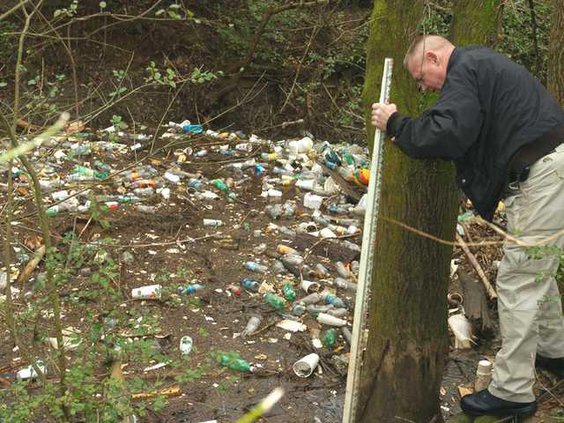The work of a pesky beaver seems to be offering a disturbing glimpse at what flows through Hall County streams toward Lake Lanier.
A beaver dam has been backing up a wall of floating garbage on a portion of Flat Creek at the Atlas Industrial Park in Gainesville since at least late December. Flat Creek empties into Lake Lanier — the region's key water source.
Yards of litter ranging from plastic foam fast food cups to children's toys to bottles once containing beer, soda, engine oil and prescription drugs are crudely collected downstream of Hilton Drive.
The mess was first reported to authorities and The Times on Dec. 28 by Jerry Hill, a Gainesville resident who delivers packages in the industrial park. Hill said it looked like "a whole Dumpster of trash had been poured into the creek."
"I don't want to come across as a tree-hugger," Hill told The Times, "but I do care about the drinking water."
The source of the trash isn't likely a single litterbug dumping in the creek, said Gainesville Environmental Monitoring Coordinator Brian Wiley, but is instead a collection of loose litter that's been washed to the creek.
"It looks like the trash came through runoffs in our storm-drain system either through heavy winds or rains when people throw things out," he said.
In other words, trash tossed on the side of the road or left out in the elements is getting carried by wind and rain to the city's drainage system, which empties into the streams and creeks.
Wiley said Flat Creek is a magnet for trash because of all the nearby roads that have storm drains leading to it.
Other than the collection of trash at the beaver dam, the creek is lined with plastic bags, bottles and even shopping carts.
The city does have environmental specialists who monitor the creek, and volunteer crews sweep the creek on occasion. However, the manpower isn't there to keep the creek pristine at all times.
If the dam was not pooling the litter together, some of it would inevitably end up in Lake Lanier, Wiley said.
Joanna Cloud is executive director of the Gainesville-based Lake Lanier Association, which leads annual shore cleanups.
Cloud said 30 tons of trash per year is collected from around the lake through volunteer efforts. She said much of that trash comes from recreational use around the lake, and she couldn't quantify how much trash comes from streams and creeks of neighboring communities.
But what trash is in the lake is more than a visual nuisance, she said.
"It truly is unsanitary and creates an unhealthy environment, said Joanna Cloud. "You and I are drinking out of the water. It's ending up in your cup of coffee and my cup of tea."
Wiley agrees to a point, saying local water treatment plants clean up the water, but agrees there are a myriad of safety issues posed by the litter.
Still, four weeks after the trashed dam was reported, it remains in place and is accumulating more garbage.
The problem is not being ignored, Wiley said, but coming up with a strategy for removing the trash is proving to be a conundrum.
The physical makeup of the creek where the trash is pooling is problematic.
That's due to depths of more than three feet of cold water with a muddy, murky bottom possibly riddled with nails or trash that could be tripped over. Steep banks and brush surrounding the creek make it hard to get in and out of the water.
"It's a safety issue," Wiley said. "I don't want to stick my staff in water that deep."
Cold and wet weather conditions are not helping, either.
Still, Wiley told The Times on Tuesday, he expects the issue could be resolved "within two weeks."
Wiley said crews may try to remove the dam and collect the trash as it comes down. Another option is clearing the brush and using pool nets to scoop the surface debris.
That won't be a permanent solution if the beaver rebuilds, said Tim Sims, an environmental specialist with the city.
It also won't solve the problem of litter flowing to the creek and the lake.

